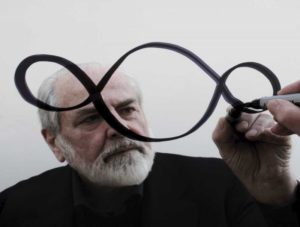“We will recount the work of one of the major representatives of contemporary art, in particular the Arte Povera movement: the Third Paradise, by the great artist Michelangelo Pistoletto. His sign consists in an infinite composed of three circles: the third is the fusion of nature and artifice, the myth of a world that is the child of a new humanity projecting itself into the future”. This is how the radio commentator and singer Alma Maneraintroduced the latest episode of her programme #Artlover¹, broadcast on RaiPlay Sound starting from today; the episode was in fact dedicated to the founder of Cittadellarte, with a focus on his sign-symbol. To articulate the radio narration of the episode – entitled Terzo Paradiso, l’Infinito (Third Paradise, the Infinite) – she availed herself of the contribution of Fernando Miglietta, architect, artist, essayist, critic, art history professor and scientific director of the magazine Abitacolo. Before talking about “the disruptive topicality of the Third Paradise”, the presenter started the dialogue with her guest by questioning him about his past and his relationship with art: “My love for art was born with me. Art, like love, is an enigma. As a child,” Miglietta recalled, “I started favouring forbidden visions: space, the horizon and infinity, which are still extraordinary themes in my creative and theoretical research”.

After an introspective game of mirrors, the journalist closed in on the artist: “Pistoletto is first and foremost a friend, a special travelling companion, as well as a member of Abitacolo’s scientific committee,” the essayist pointed out, “he is one of the artists who have privileged a critical view of reality: his research and his art are in fact a continuous questioning of the genesis of a new society. His Third Paradise and his mirror paintings are, after all, a pedagogical tool and at the same time a grammatical alphabet of the future at the service of a community that he interrogates with his trinamic symbol, on which a new path of democracy and civilisation can be built. This is the ideological and philosophical matrix his art is based on”. The presentation of Pistoletto as an artist was followed by that of his trinamic symbol, which Miglietta described as “a participatory work. This symbol is an expression of relational art, which wants to build community around an idea: it is based on the ritual of sharing and requires interaction and relationship”.

Manera then dwelt on the concept of identity, asking the professor how it is represented in Pistoletto’s art. “Michelangelo experiments with and achieves,” she asserted, “the total representation of the concept of identity in the mirror paintings and in the Third Paradise, where we find the passage from the ‘I’ to the ‘we’, that is, to a plural and participatory condition. With the trinamic symbol, he has also conceived a collective work that involves children, adults, artists and different ideologies”. An artistic and social process that could be articulated thanks to Cittadellarte. And it is precisely to the institution in Biella that Miglietta dedicated a thought when the presenter invited him to point out two representations of the symbol of the Third Paradise: “At the Pistoletto Foundation there is the permanent home of the Third Paradise. I also want to mention the one in Assisi: I believe that the land art work in Saint Francis Wood,” he concluded, “is a unique, poetic and mystical intervention. It is also a way for Pistoletto to convey a message of environmental protection, inviting us to become custodians of creation, because he wants to generate a new balance through a dialogue between nature and artifice”.

